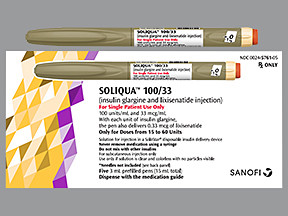INSULIN GLARGINE/LIXISENATIDE - INJECTION
PHONETIC PRONUNCIATION: (IN-su-lin GLAR-jeen/LIX-i-SEN-a-tide)
COMMON BRAND NAME(S): Soliqua
GENERIC NAME(S): insulin glargine,human recombinant analog/lixisenatide
Uses
USES: This medication is a combination of insulin glargine and lixisenatide and is used with a proper diet and exercise program to control high blood sugar in people with type 2 diabetes. Controlling high blood sugar helps prevent kidney damage, blindness, nerve problems, loss of limbs, and sexual function problems. Proper control of diabetes may also lessen your risk of a heart attack or stroke. Insulin glargine is a man-made product that is similar to human insulin. It acts longer than regular insulin, providing a low, steady level of insulin. It works by helping blood sugar (glucose) get into cells so your body can use it for energy. Lixisenatide is similar to a natural hormone in your body (incretin). It works by causing insulin release in response to high sugar levels (such as after a meal) and decreasing the amount of sugar your liver makes.
How to use INSULIN GLARGINE/LIXISENATIDE - INJECTION
HOW TO USE: Read the Medication Guide and Instructions for Use provided by your pharmacist before you start using this medication and each time you get a refill. Learn all preparation and usage instructions. If you have any questions, ask your doctor or pharmacist. Before using, check this product visually for particles or discoloration. If either is present, do not use the liquid. Before injecting each dose, clean the injection site with rubbing alcohol. Change the injection site each time to lessen injury under the skin. Inject this medication under the skin in the thigh, abdomen, or upper arm as directed by your doctor, usually once daily within 1 hour before the first meal of the day. Use a new needle for each injection. Do not inject into a vein or muscle because very low blood sugar (hypoglycemia) may occur. The dosage is based on your medical condition and response to treatment. Lixisenatide can slow down or decrease the absorption of other drugs such as birth control pills, antibiotics, or acetaminophen. Take other medications at least 1 hour before using this medication. Take birth control pills at least 1 hour before or 11 hours after using this medication. If you must take these other medications with food, take them with a meal or snack when you are not using this product. Ask your doctor or pharmacist if you have any questions about when to take your medications. Do not share your pen device with another person, even if the needle is changed. You may give other people a serious infection, or get a serious infection from them. Learn how to store and discard medical supplies safely. Use this medication regularly to get the most benefit from it. To help you remember, use it with the same meal each day. Tell your doctor if your condition does not get better or if it gets worse (your blood sugar is too high or too low).
Side Effects
Precautions
Interactions
Overdose
Images
Reviews
Faq for INSULIN GLARGINE/LIXISENATIDE - INJECTION
Insulin Glargine/Lixisenatide injection is a combination medication used to treat type 2 diabetes. It helps to control blood sugar levels by regulating insulin levels and reducing glucose production in the liver.
Insulin Glargine/Lixisenatide injection is typically injected once daily within one hour before the first meal of the day. It should be given as directed by your healthcare provider and the injection site should be rotated to avoid lipodystrophy (changes in the fatty tissue under the skin).
Common side effects may include nausea, vomiting, diarrhea, headache, and injection site reactions such as redness or pain. Contact your doctor if you experience more severe side effects like signs of hypoglycemia (low blood sugar) such as sweating, shakiness, or dizziness.
Insulin Glargine/Lixisenatide injection should only be used during pregnancy if clearly needed and prescribed by your doctor. It is important to discuss the potential risks and benefits with your healthcare provider.
The safety and effectiveness of Insulin Glargine/Lixisenatide injection have not been established in children under the age of 18. Consult with a pediatric specialist for appropriate treatment options for children with type 2 diabetes.
If you miss a dose, take it as soon as you remember, unless it is within 3 hours of the next scheduled dose. In that case, skip the missed dose and continue with your regular dosing schedule. Do not take a double dose to make up for a missed one.
It is important to inform your healthcare provider about all the medications you are taking, including prescription, over-the-counter, and herbal products. Some medications may interact with Insulin Glargine/Lixisenatide injection, including insulin or oral diabetes medications.
Disclaimer
IMPORTANT: HOW TO USE THIS INFORMATION: This is a summary and does NOT have all possible information about this product. This information does not assure that this product is safe, effective, or appropriate for you. This information is not individual medical advice and does not substitute for the advice of your health care professional. Always ask your health care professional for complete information about this product and your specific health needs.

No Reviews Yet